It sounds simple right? It's just a place for your cat to do his or her business, but the huge range of available trays and litters can be a little confusing for some. Even if your cat is an "outdoor" cat it is highly recommended that you keep a litter tray indoors for any such eventuality. Some cats are pretty much happy-go-lucky and are not bothered by the choices you make, but a majority you will find will be very picky. What is important is to stick with what works.
Getting the right combination is essential, and there are a few things to bear in mind when making a choice as to what will be best for you and your cat(s). Here is a quick set of pointers to help you out!

Recommended if you do not mind occasionally catching something you do not really want to see! Bear in mind - some cats get a little fussy about being "seen" while answering the call of nature, so if you find your cat is not using this at all, you should probably consider a covered tray. These trays are relatively cheap and durable.
Some vets recommend an open-top tray where clay-based litters are being used. The digging action of the cat may kick up dust, which in an enclosed litter box could lead to respiratory difficulties in some cats.
If your cat likes to spend time burying the evidence, you may need to spend extra time cleaning up excess litter on the floor. Its also worth bearing in mind this option is probably the least hygienic. You can purchase one here.
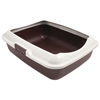 Lipped litter trays have one obvious difference - an addition of a "spill" guard to help minimise the amount of litter spillage onto the floor. A popular choice among cat owners. A range of rimmed trays are available by clicking here.
Lipped litter trays have one obvious difference - an addition of a "spill" guard to help minimise the amount of litter spillage onto the floor. A popular choice among cat owners. A range of rimmed trays are available by clicking here.
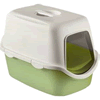
A fully-enclosed litter tray acts to minimise external mess, as well as to keep the smell under control through use of carbon filtering systems (refills can be purchased by clicking here) - common to this type of litter tray. Ideal for places where you have no choice to place the litter tray in such as kitchens. Some cats may be a little picky and dubious to enter these porta-loo style litter boxes, but most cats welcome the privacy. Click here to browse our range. It is recommended that dust-free litters should be used in an enclosed litter tray.
Some litter products may combine some or all of the below traits; it's always best to try out a few to suit your cats and your budgetary needs.
Clum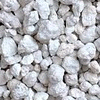 ping: Clumping litter simply "clumps" into balls when it comes into contact with liquids or solids. Some cat owners prefer this as it makes it easier to "scoop" out the dirty litter using a litter tray scoop. This is quite a good option if you want to save money on cat litter, as it makes it easier to scoop out the dirty litter. An example of Clumping litter is here.
ping: Clumping litter simply "clumps" into balls when it comes into contact with liquids or solids. Some cat owners prefer this as it makes it easier to "scoop" out the dirty litter using a litter tray scoop. This is quite a good option if you want to save money on cat litter, as it makes it easier to scoop out the dirty litter. An example of Clumping litter is here.
Dust Free: Dust-free litter is for cats that have a certain sensitivity to dust and fine air pigments. When the litter is poured into the tray or disturbed while your cat is burying, dust particles are not thrown into the air and therefore will not affect your pet.
Scented: Litter that is heavily scented to help disguise the smell of your cats mess. It is worth remembering that bad smells can not ever be 100% removed from the cat litter tray. You can also purchase a separate agent that can be added to litter to help disguise the smell. An example of scented litter is here.
Sand or Clay Based: These litter types absorb liquids and solids extremely quickly, but do not eliminate smell. Usually the cheapest option. This is a good example of clay-based litter.
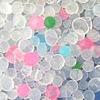 Silica based litter:Silicon or Sand-crystal based: These litter types are excellent at absorbing urine and odour very quickly, but can be relatively expensive. Can be a bit tricky if dropped on the floor, but an excellent choice if you want to eliminate odour very quickly and with little mess. Catsan is a good example of silicate-based litter.
Silica based litter:Silicon or Sand-crystal based: These litter types are excellent at absorbing urine and odour very quickly, but can be relatively expensive. Can be a bit tricky if dropped on the floor, but an excellent choice if you want to eliminate odour very quickly and with little mess. Catsan is a good example of silicate-based litter.
Wood-chip or sawdust-based: Good absorbency, and mediocre odour control, this type of litter is a relatively new idea so can be an expensive option. Good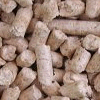 for the environment as the core element of it is a by-product. Click here for an example of a wood-based litter.
for the environment as the core element of it is a by-product. Click here for an example of a wood-based litter.
There are also some other options available, such as soil from your garden or ripped up newspaper, and whereas these are available very cheaply in abundance they are not ideal for cat litter trays. Paper will, for example, stick to your cats feet, and ink from the paper can get onto your cats feet.
It is also worth noting that managing smell is something you have to work at. Scooping twice a day, and completely emptying the litter tray at least once a week will ensure smell is kept to a minimum. You can add a plastic liner to your litter tray but bear in mind, cats love to scratch in the tray which cold see your lining be ripped into strips.